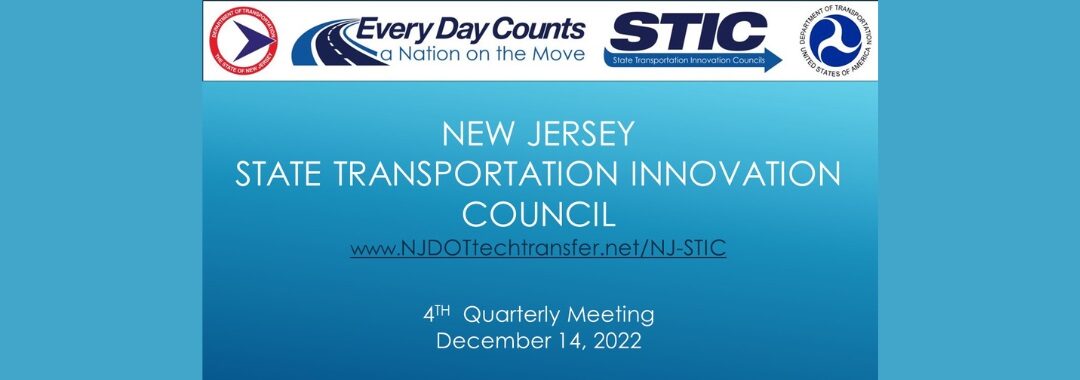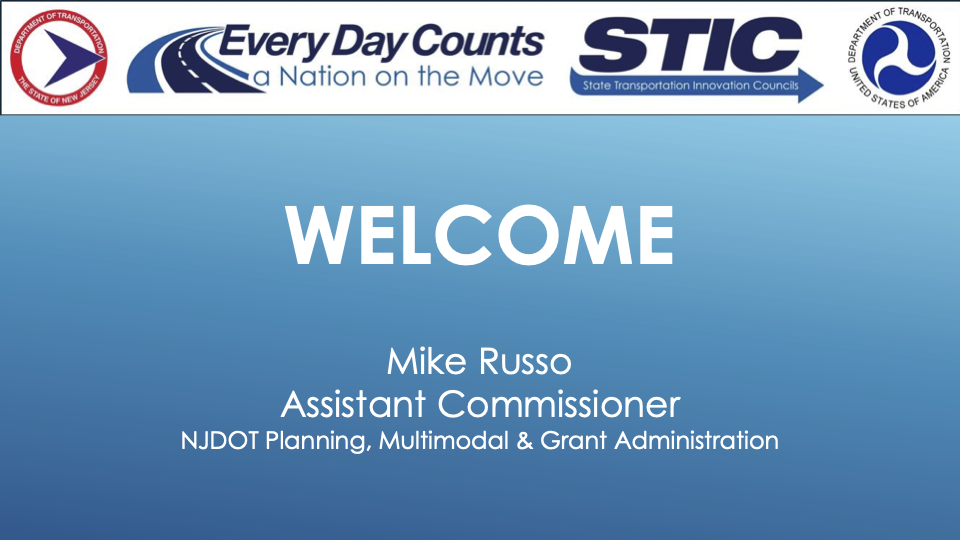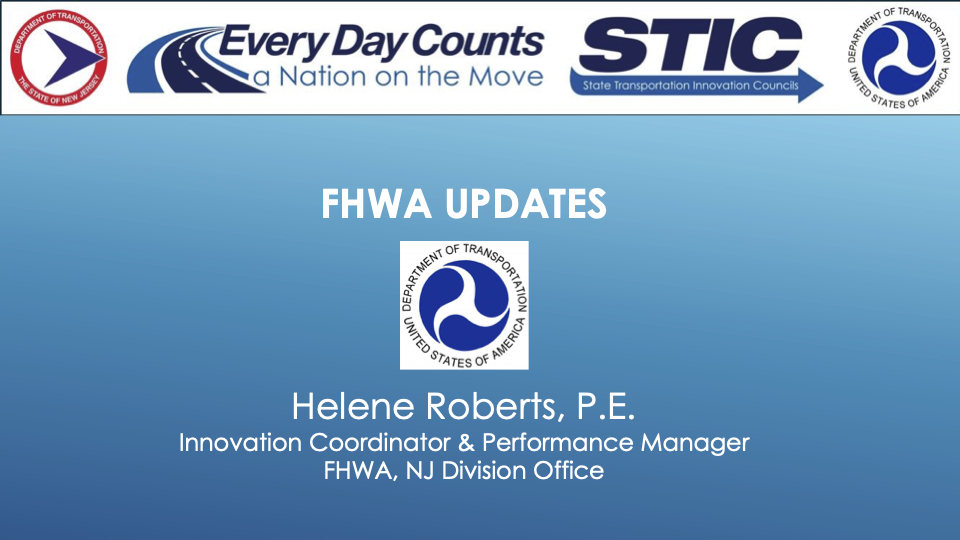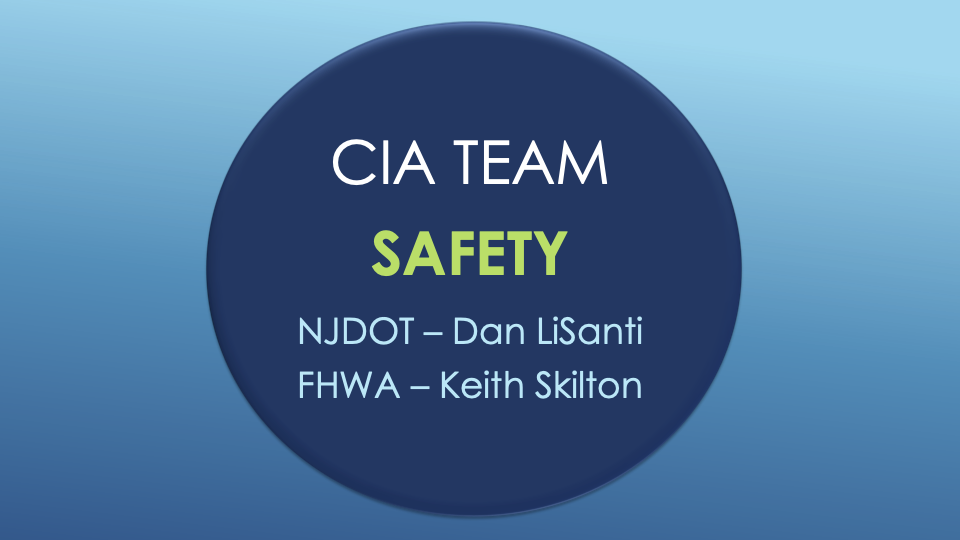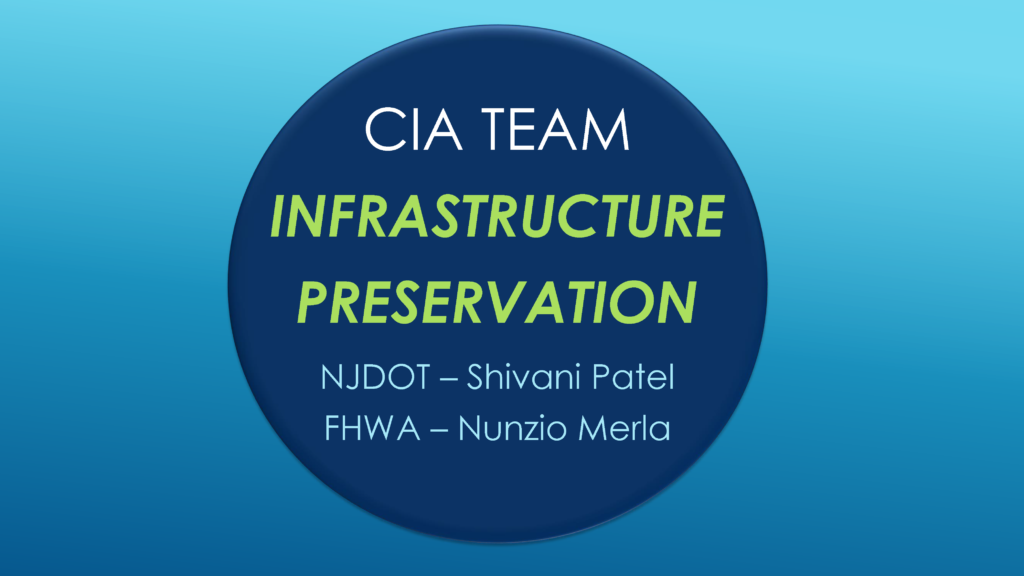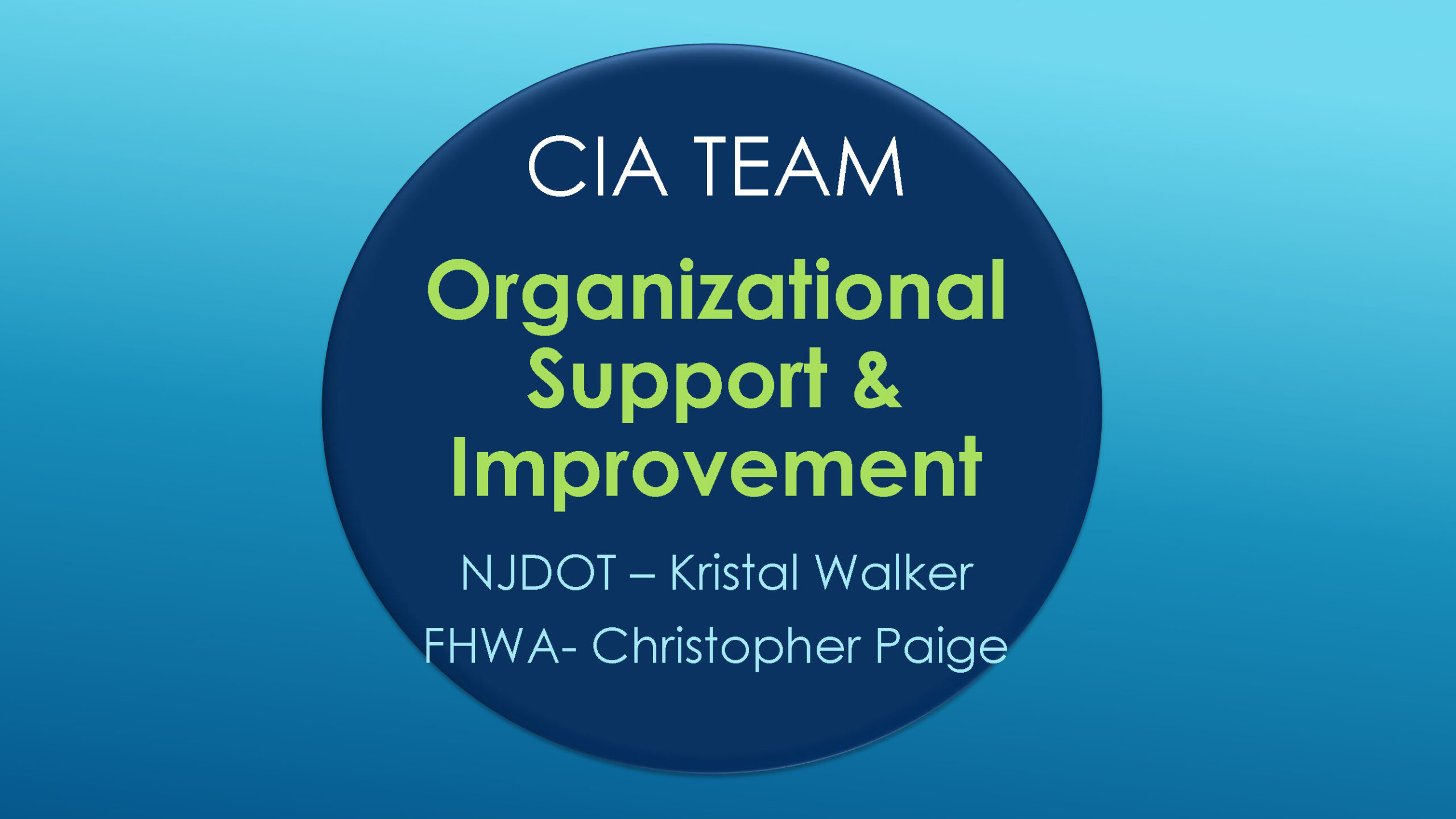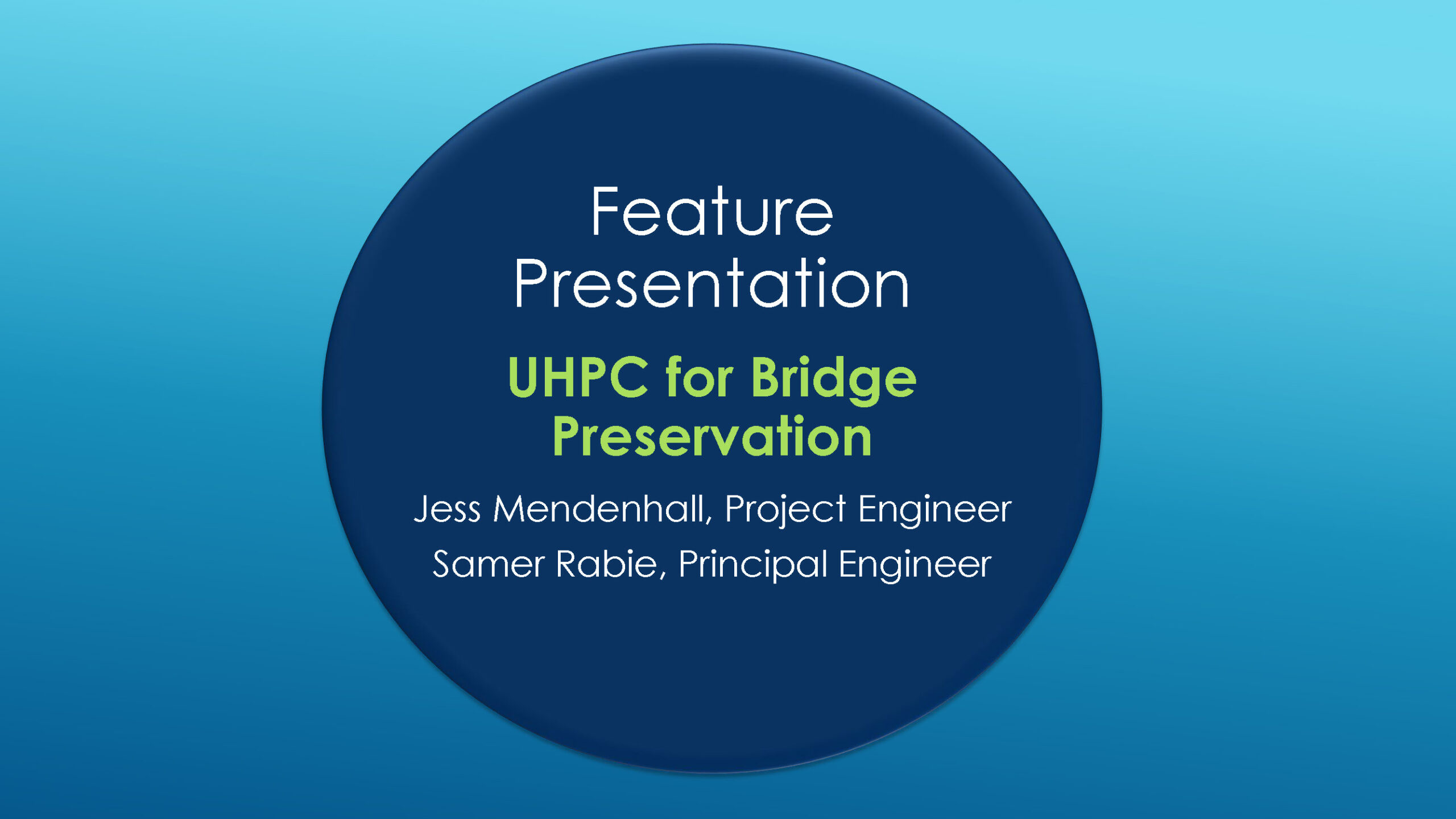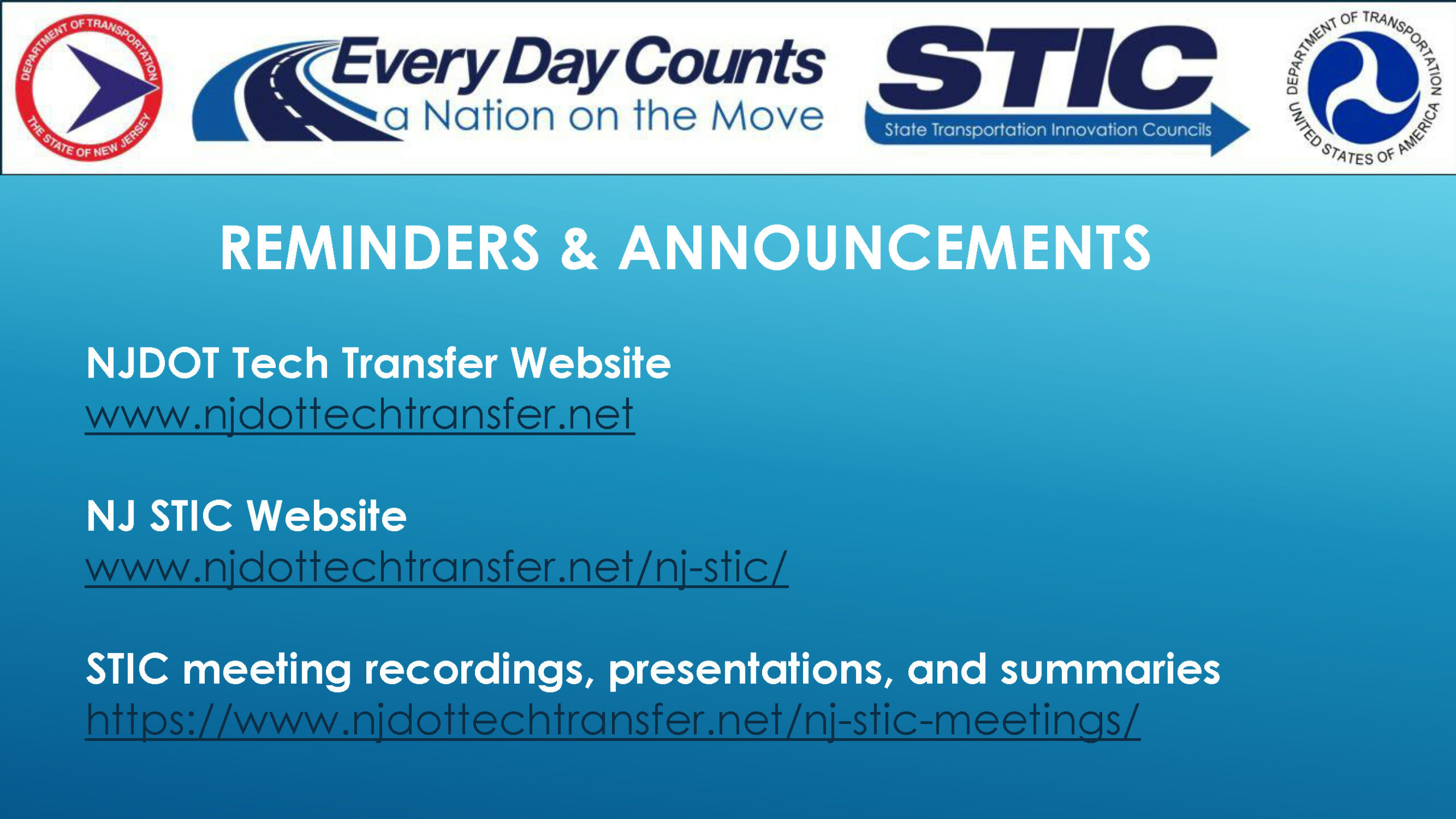The NJ State Transportation Innovation Council (NJ STIC) convened online for the 4th Quarter Meeting on December 14, 2022. The STIC Meeting Agenda had been distributed to the invitees prior to the meeting. Participants could use the chat feature to offer comments or ask questions of the speakers during the online meeting.
Brandee Sullivan (Chapman), NJDOT Innovation Coordinator greeted the meeting participants, followed by Assistant Commissioner Michael Russo who provided the Welcome and Opening Remarks. He announced that the NJ STIC was awarded the FHWA STIC Excellence Award, for development of the STIC Communications Plan, creation of a full-time Innovation Coordinator position, and creation of a new core innovation area related to Organizational Improvement and Support. This is the second STIC Excellence Award received by NJ STIC.
FHWA EDC Innovation. Helene Roberts, Innovation Coordinator and Performance Manager for the FHWA NJ Office, noted that the EDC-7 cycle will be beginning in January 2023. She highlighted the seven initiatives that will be part of the next cycle: Nighttime Visibility for Safety; Next Generation TIM: Technology for Saving Lives; Integrating GHG Assessment and Reduction Targets in Transportation Planning; Enhancing Performance with Internally Cured Concrete (EPIC2); EPDs for Sustainable Project Delivery; Rethinking DBE in Design-Build; and Strategic Workforce Development. She noted that the FHWA EDC-7 Summit will be held from February 14-16, 2023 as a virtual event. The Summit will be followed by a NJ STIC Caucus on February 22, 2023.
Core Innovation Area (CIA) Updates. The meeting continued with presentations from Core Innovative Area (CIA) leaders who provided updates of the status of EDC initiatives on the topics of Safety, Infrastructure Preservation, Mobility and Operations, and Organizational Improvement and Support.
There was a brief break during which meeting participants could take part in an online transportation trivia quiz on innovations promoted through the Every Day Counts Program since its inception.
Featured Presentation – Ultra High Performance Bridge Preservation. Jess Mendenhall, Project Engineer, and Samer Rabie, Principal Engineer from NJDOT’s Structural Value Solutions Unit presented on the design, construction, and evaluation of Ultra-High Performance Concrete (UHPC) Bridge Deck Overlays for NJDOT. The NJDOT Structural Value Solutions unit has been exploring the use of UHPC in bridge preservation and rehabilitation projects, an emerging application of UHPC in the United States. Bridge deck overlays were placed on four New Jersey bridges.
Mr. Mendenhall described the composition of the material and its superior mechanical and durability properties. He observed that the the advantages to using the material include preservation of bridge elements in good or fair condition and extension of the service life of bridge decks yielding potential life cycle cost savings. The disadvantages include the cost of the material, limited contractor experience with use of UHPC as an overlay, and the workability of the overlay mix. The cost of using UHPC tends to be higher than that of conventional overlay, and lower than replacement of the bridge deck.
Fully understanding the existing bridge condition and determining the remaining service life of primary structural components (i.e., the deck, superstructure and substructure) are crucial in choosing whether to proceed with deck preservation using UHPC overlay or conventional deck replacement and rehabilitation. Mr. Mendenhall provided an illustrative example of how a life cycle cost analysis can help support the decision of preservation versus reconstruction of a bridge.
Mr. Mendenhall described the research process and criteria used for the selection of the four bridges, among other candidates, for advancement into design and construction for UHPC Bridge Deck overlay to permit testing of UHPC. Eight candidate structures were fully evaluated and tested before the four bridge structures were advanced. In this stage, testing was performed on current deck conditions. All structures included in the program were evaluated for suitability based on the structural evaluations, chloride content within the deck, feasible construction stages, traffic analysis results, and existing overlay depths. Chloride content was obtained from concrete core samples on each bridge deck.
The bridges that were ultimately selected varied in their age, size and design. All the bridges had asphalt overlay. The selected bridges for the pilot program were in good condition to leverage the perceived long life-span of UHPC and not allow other factors to limit the potential service life. Two of the bridges selected were less than 10 years old, and two bridges were 30-40 years old.
In the design phase, the finished bridge deck elevation was required to match the existing elevations. Various solutions were found for the four bridges including a thin overlay, a 1.5” overlay with an asphalt topping, and a 2.75”UHPC overlay with no asphalt topping. Design solutions avoided excessive UHPC overlay to control costs.
Mr. Mendenhall described the preferred surface conditions for the application of UHPC and the rationale for a hydrodemolition specification to remove the upper half inch of the existing deck surface. This process results in a roughened surface with exposed aggregate which is the ideal bonding surface for UHPC that limits microfractures that can affect bond performance compared to other technologies such as diamond grinding and milling.
During his presentation he also spoke about the staging of construction into two stages for all bridges, highlighting specifications and joint details to prevent water intrusion and provide structural continuity in the deck slab. Exposed fiber finish was specified to promote bonding between stages of UHPC application to ensure an exposed aggregate finish suitable for UHPC application. He highlighted the need for full depth and reconstruction with UHPC to full depth at deck joints which can be susceptible to deterioration.
Samer Rabie discussed UHPC materials specifications and testing, specifications for construction processes, lessons learned, the evaluation process, and the focus of future assessments. He shared video examples of UHPC placement in the field and discussed design and construction special provisions, use of specialized equipment, mixing and application of UHPC, the importance of exposed fibers, the expertise required of the workforce and contractors, and proper curing and finishing, among other topics.
Several lessons learned were shared, including an expectation that NJDOT would seek in the scoping and concept development stage to identify project locations that could use UHPC as a final riding surface (rather than asphalt) to enable its evaluation, inspection and characterization for representative condition ratings for the future. However, if an overlay is needed on top of UHPC for geometry or profile, the agency will consider BDWSC (Bridge Deck Waterproof Surface Course) or High Performance Thin Overlay materials.
To measure the existing conditions, the use of ground-penetrating radar (GPR) should be used to determine concrete cover, overlay thickness and reinforcement locations and to determine the causes of delamination.
Two special provision items will emphasize the use of surveys to inform depths of hydrodemolition and material qualities required for placement to ensure continuous operation and to specify watertight forms, top forms, minimum overfill, and surface grinding.
Mr. Rabie also outlined construction considerations and challenges in the application of UHPC and proper staging. He described how UHPC slurry with no fibers was placed in air voids in response to surface defects before asphalt paving and emphasized that proper repair methods in contract documents should be defined to address aesthetic or structural anomalies.
Mr. Rabie also described in some detail the testing methods that have been used for annual evaluations for two bridges, including non-destructive impact echo testing and ultrasonic tomography, as well as physical sampling and lab testing. The ultrasonic tomography and impact echo testing indicated that the bond between UHPC and concrete substrate is sound and that the chloride content was within expectations.
In his concluding remarks, Mr. Rabie observed that the baseline testing was successful, with no significant defects encountered. NJDOT is considering installing UHPC overlays on newly constructed decks as well as decks with lower condition ratings for future projects. A deeper overlay (with deeper existing deck removal) will be regarded as a viable alternative for structures that need a major deck rehabilitation. NJDOT is also incorporating UHPC for several applications in the new design manual, including P&R. In future studies, the team will seek to better understand deterioration rates of UHPC. The presenters also responded to questions related to the approximate service life of UHPC and its tensile capacity.
Reminders and Updates.
Mrs. Sullivan (Chapman) announced that NJDOT received the 2022 America’s Transportation Award for Best Use of Technology and Innovation for the Implementation of Drivewyze on 647 miles of NJ’s Highways.
Mrs. Sullivan (Chapman) provided reminders on the online location of several resources that highlight the NJ STIC and other innovation topics funded through research and technology transfer activities, including:
- NJDOT Tech Transfer Website – http://www.njdottechtransfer.net/
- NJ STIC Website – https://www.njdottechtransfer.net/nj-stic/
- NJ STIC Meetings – https://www.njdottechtransfer.net/nj-stic-meetings/
She reminded the attendees to save the dates for the FHWA EDC-7 National Summit and the NJ STIC Caucus. The EDC-7 Summit will be held from February 14-16, 2023 as a virtual event, featuring some states that have used the initiatives successfully, and an Innovation Showcase. The Summit will be followed by the NJ STIC Caucus on February 22, 2023 from 10:00am-12:00pm. During the Caucus, the NJ STIC will discuss the opportunities and barriers of the new initiatives and consider what initiatives New Jersey should pursue.
STIC Incentive Program funds are still available for 2022 and more funds will be available soon for the coming year. The FHWA offers these funds, as well as technical assistance, to support the costs of standardizing innovative practices in a state transportation agency or other public sector STIC stakeholder. NJ STIC receives $100,000 each year. Mrs. Sullivan (Chapman) asked that the STIC network members communicate these grant opportunities through their networks. Local public agencies are eligible to apply. Find more information, including examples of allowable activities and prior recipients, here.
Mr. Russo provided closing remarks.
NJ STIC December 2022 Meeting Recording

